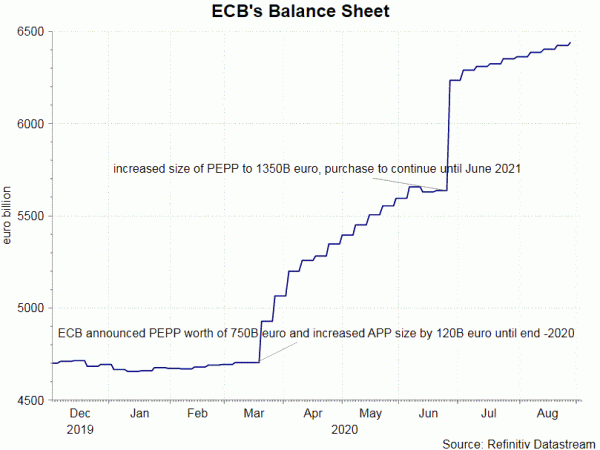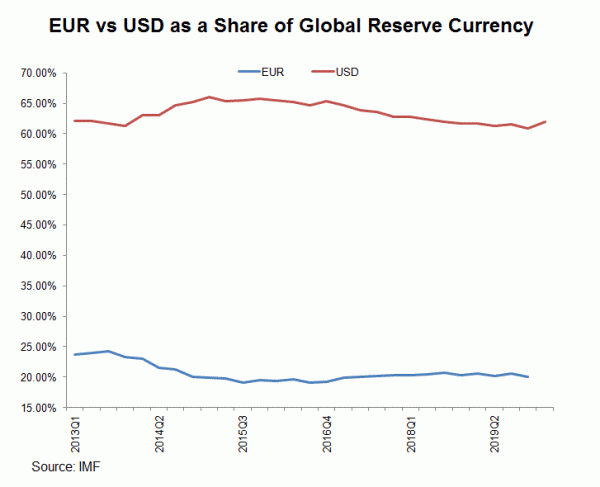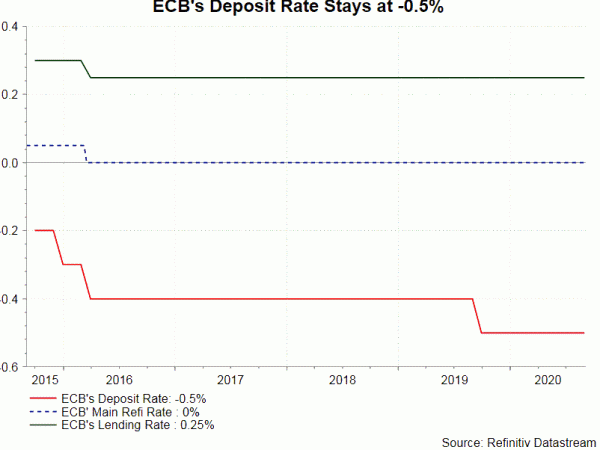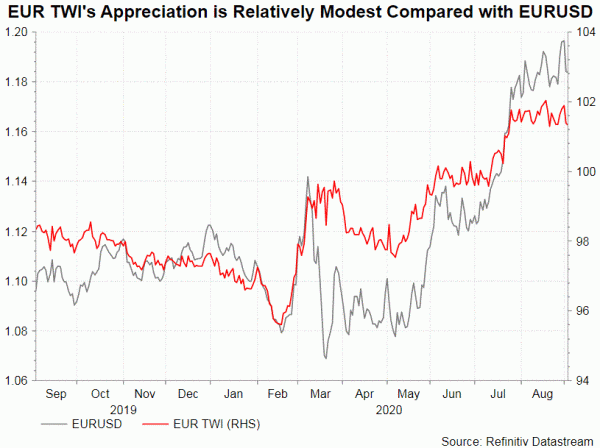Products You May Like
ECB is expected to maintain the monetary policy measures in September. The focuses on the meeting include policymakers’ response to the recent strength in euro, the updated economic projections and ECB’s strategy review after Fed Chair Jerome Powell’s announcement at the Jackson Hole symposium. While euro’s appreciation over the past months could be a drag on recovery and the inflation outlook, the impacts are likely limited for now. Policy actions to curb the rally are not yet warranted. Yet, some verbal intervention at the press conference is likely. It is also possible that the inflation outlook would be revised lower, reinforcing ECB’s dovish stance.
ECB should maintain the deposit rate at -0.5%. The main refi rate and the marginal lending rate will also stay unchanged at 0% and 0.25% respectively. The PEPP program will continue to run with a total envelope of 1.35 trillion euro. We expect the central bank will reiterate the guidance that the purchases “will” continue “until at least the end of June 2021 and, in any case, until the Governing Council judges that the coronavirus crisis phase is over”.
– advertisement –
 Market speculations have increased over whether ECB would act to curb recent rally in the single currency, particularly after ECB Chief Economist Philip Lane’s speech at Jackson Hole. Lane raised concerns that rising EURUSD could prolong weak inflation and inflation expectations. As he suggested, “we have an inflation mandate and we care about the overall performance of the European economy”. He added that there has been “a repricing in recent weeks” in EURUSD “to some degree”.
Market speculations have increased over whether ECB would act to curb recent rally in the single currency, particularly after ECB Chief Economist Philip Lane’s speech at Jackson Hole. Lane raised concerns that rising EURUSD could prolong weak inflation and inflation expectations. As he suggested, “we have an inflation mandate and we care about the overall performance of the European economy”. He added that there has been “a repricing in recent weeks” in EURUSD “to some degree”.
EURUSD has strengthened almost +10% since May. Trade-weighted index (TWI) euro has gained about +3.5% during the period. In theory, currency appreciation could reduce import prices and eventually core goods prices. This would pose downward pressure on the central bank’s inflation forecast. In June, ECB projected inflation to only reach +0.3% y/y this year, followed by modest improvement to +0.8% and +1.3% in 2021 and 2022, respectively. Recent EUR appreciation would lead to further downgrade of the above forecasts.
The more modest appreciation in TWI term suggests that a key reason for the euro’s strength is USD’s weakness. Meanwhile, it signals that the impacts have remained limited on most of Eurozone’s trading partners. It is expected that a +10% appreciation in euro cold lead to -100 bps decline in real GDP in 2 years. This is insignificant compared to June’s projection of a -8.7% contraction this year.
Besides, euro’s strength has been driven some positive factors, including a more encouraging recovery outlook in the bloc as well as optimism over the stimulus brought about by the recovery fund. Meanwhile, euro’s use in the international arena has risen as credibility of the US dollar is at risk. Euro as the global payment currency increased to 36.5% as of July, highest since 2013. This signals that international companies are more willing to accept euro as payments, and could pave the way for the single currency to become a more important reserve currency. As of March, only 20% of the world’s reserves were held in EUR, compared with over 60% held in USD.



